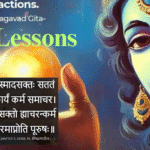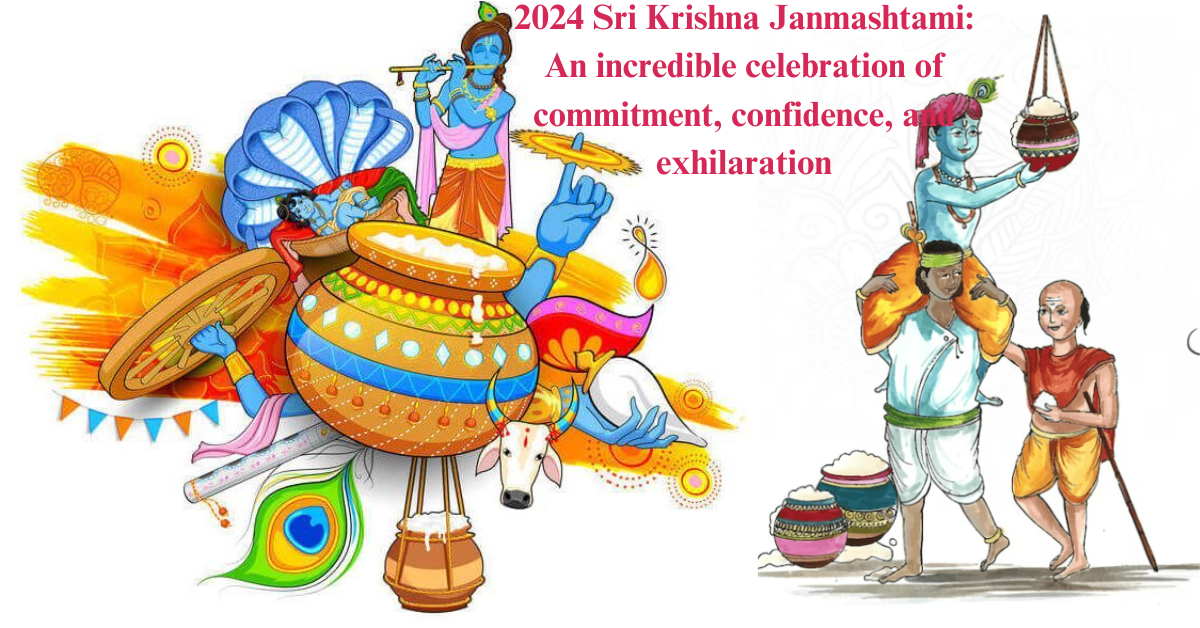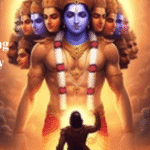“The Supreme Guidance of Life: The Eternal Principles of the Bhagavad Gita”
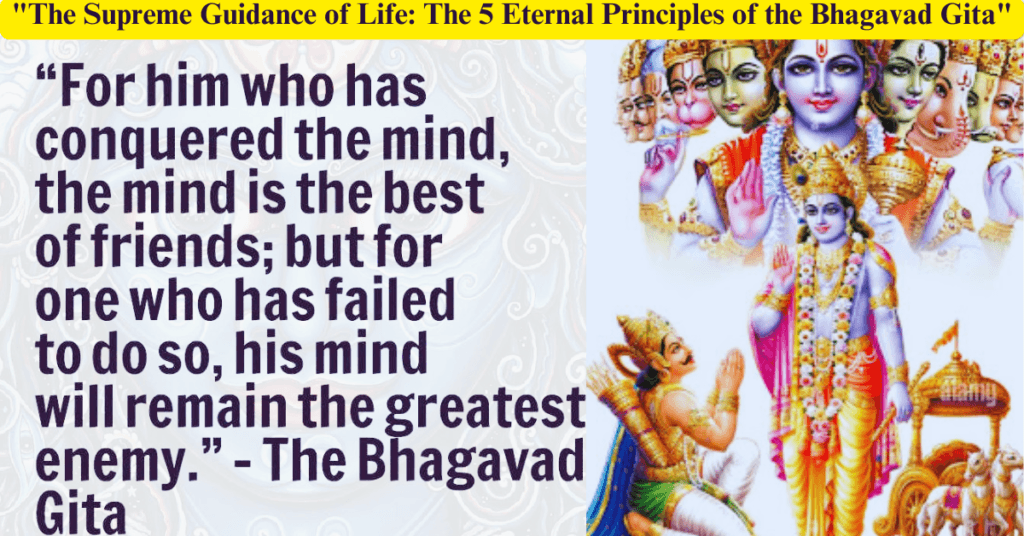
Table of Contents
Bhagavad Gita is a unique text of Indian literature that has been guiding humanity for centuries. It is not just a religious book, but it is a unique creation that solves the mysteries of life and leads to self-realization. The teachings given by Lord Krishna to Arjuna during the Mahabharata war were compiled in the form of Bhagavad Gita, in which the eternal principles of life, dharma, karma, devotion, and soul have been described in detail.
The teachings contained in the 18 chapters of the Bhagavad Gita are not limited to any particular religion, caste, or society; they provide the highest guidance of life for the entire humanity. The purpose of these teachings is to provide a balanced approach to life to the individual, which not only inspires him towards spiritual advancement, but also helps in achieving balance and prosperity in all spheres of life.
Historical and Cultural Perspective of the Gita
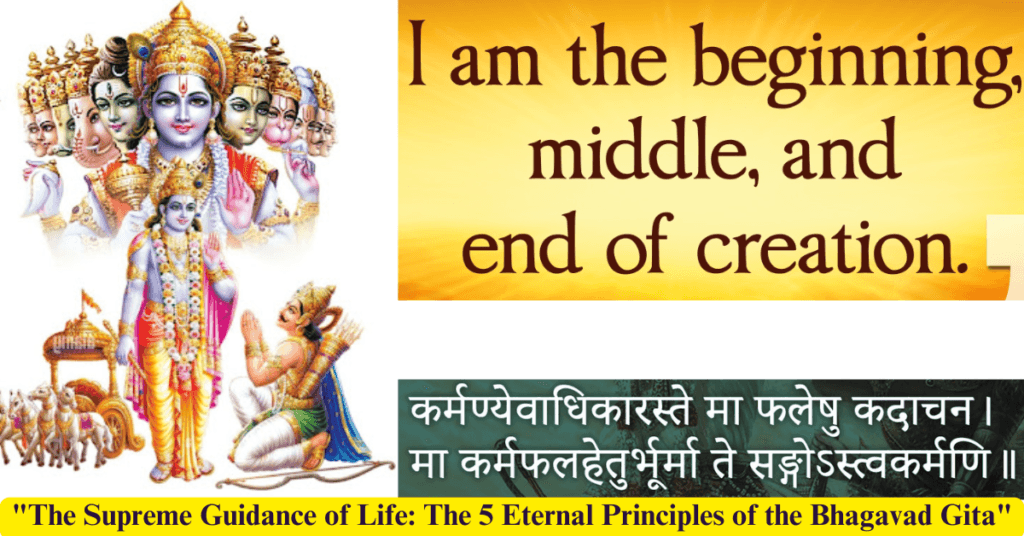
The war of Mahabharata took place between the Kauravas and the Pandavas in Kurukshetra, which is an important chapter in Indian history. This war was not just a struggle for power between two families, but it was a struggle between Dharma and Adharma.
The Bhagavad Gita originated during this struggle, when Arjuna was in a state of confusion and dilemma to fight against his own brothers and relatives in the battlefield. Arjuna thought of retreating from the war, but then Lord Krishna reminded him of his duties and made him aware of the highest truth of life. Through the Gita, Lord Krishna inspired not only Arjuna but the entire human race to follow their duties and Dharma.
The cultural significance of the Bhagavad Gita is widespread not only in India but all over the world. This scripture is beyond the boundaries of time and place and has been relevant in every era. The Gita has inspired thinkers, philosophers and spiritual gurus not only in Indian society but also around the world. Great personalities like Mahatma Gandhi, Swami Vivekananda, Maharishi Arvind imbibed the teachings of the Gita in their lives and tried to bring change in the society through them.
Eternal Principles of Bhagavad Gita
The principles mentioned in the Bhagavad Gita are not limited to religious or spiritual life; they affect every aspect of life. The teachings of the Gita inspire a person to adopt a balanced approach towards life, which not only gives him spiritual peace but also leads him towards success in social and personal life. Let us analyze these eternal principles of the Gita in depth:
- Karmayoga: The Principle of Disinterested Action
The main principle of the Bhagavad Gita is Karmayoga, which inspires a person to perform his duties. Lord Krishna preached to Arjuna that we should perform our actions without any desire for any fruit. This principle is one of the main teachings of the Gita and can be applied in every sphere of life. Karmayoga means that a person should perform any work in his life without any personal interest, only as his duty. According to the Gita, this is the highest dharma of human life.
Karmayoga is not limited to physical actions but it also includes mental and spiritual actions. Gita teaches us that we should dedicate our actions to God and not worry about their results. Lord Krishna says, “Karmanyewadhikaraste ma phaleshu kadachana.” That is, you have the right only to do your duty and not to its results. This principle of Karmayoga helps a person to develop self-confidence, patience and a sense of selflessness in his life.
An important aspect of the principle of Karmayoga is that it makes a person loyal and dedicated towards his duties. This principle leads a person to achieve success in every sphere of his life. Whether it is personal life, social life, or professional life – the principle of Karmayoga is relevant everywhere.
- Gyanyoga: The path to self-realization
Gyanyoga highlights another important aspect of Gita. Gyanyoga means understanding the relationship between the soul and the Supreme Soul and attaining self-realization. This path makes a person realize his true identity. According to the Gita, the soul is immortal and indestructible, while the body is mortal. Only the knowledge of the soul can free a person from the bondages of birth and death.
Lord Krishna, while explaining the importance of Gyanyoga to Arjuna, said that the soul neither takes birth nor dies. The soul is eternal, beginningless, and infinite. It is not destroyed even when the body is destroyed. It is said in the Gita, “Nainaam chhindanti shastraani nainaam dahati pavakah. Na chainam kledayantyapo na shoshyati maarutha”. That is, the soul cannot be cut by weapons, fire cannot burn it, water cannot wet it and air cannot dry it. This principle of Gyanyoga makes a person realize the eternal nature of the soul and makes him aware of the fundamental truth of life.
The principle of Gyanyoga inspires a person towards self-knowledge. It makes a person aware of his inner powers and makes him experience the eternal nature of the soul. By following Gyanyoga, a person adopts a positive attitude towards his life and realizes his true purpose. This path leads a person towards self-realization and makes him aware of the infinite possibilities of life.
An important aspect of Gyanyoga is that it makes a person aware of his inner strengths and gives him a new vision towards his life. This path motivates a person towards spiritual advancement and makes him realize his true nature. According to Gyanyoga, the experience of the eternal and indestructible nature of the soul inspires a person to adopt a positive attitude towards life.
- Bhaktiyoga: The path of love and devotion
Bhaktiyoga also has a special significance in the Gita. Bhaktiyoga means complete surrender, reverence and a feeling of love towards God. Lord Krishna says that devotion is the only path by which a person can receive the grace of God. Bhaktiyoga frees a person from his ego and inspires him to surrender to God.
Lord Krishna told Arjuna, “Manmana Bhava Madbhakto Madyaji Ma Namaskuru.” That is, meditate on me, become my devotee, worship me and bow to me. This principle inspires a person to increase his loyalty and devotion towards God. Through Bhakti Yoga, a person dedicates his mind, words and deeds to the service of God and thus attains salvation.
An important aspect of Bhakti Yoga is that it dedicates a person to God with complete devotion and reverence. Through Bhakti Yoga, a person develops a sense of love, compassion, and tolerance in his life. This path frees a person from ego and inspires him to take refuge in God. By following Bhakti Yoga, a person adopts a positive attitude towards his life and leads him towards spiritual progress.
Bhakti Yoga teaches a person that devotion is not just a religious ritual, but it is a deep emotional and spiritual experience in a person’s life. Through Bhakti Yoga, a person connects his mind and soul with complete dedication to God, which gives him mental and spiritual peace.
4. Dhyanyoga: The path to mental and spiritual peace
The Gita also mentions Dhyanyoga, which helps a person to achieve mental and spiritual peace. Dhyanyoga means to concentrate the mind and be absorbed in the meditation of God. According to the Gita, Dhyanyoga makes a person aware of his inner powers and leads him to spiritual peace.
Lord Krishna told Arjuna that through meditation a person can control his mind and surrender it at the feet of God. Through Dhyanyoga, a person controls his senses and helps him to get free from the worldly illusions of life. It leads a person towards self-realization.
The principle of Dhyanyoga provides mental and spiritual peace to a person. It makes a person aware of his inner powers and inspires him to adopt a balanced approach towards life. Through Dhyanyoga, a person controls his senses and mind and moves towards spiritual progress. This path inspires a person to attain mental and spiritual peace and leads him towards self-realization.
By following Dhyana Yoga, a person attains spiritual peace and balance by going deep within himself. This path liberates a person from his internal conflicts and mental turmoil and gives him a stable and peaceful mental state.
- Nishkam Bhaav: Freedom from Ego and Selfishness
Nishkam Bhaav also has special significance in the Bhagavad Gita. This principle inspires a person to perform his deeds without any selfishness and ego. Nishkam Bhaav means performing one’s duties without any desire for any fruit. According to the Gita, Nishkam Bhaav frees a person from the bondage of his karmas and leads him towards spiritual progress.
Lord Krishna told Arjuna, “Yogasthah Kuru Karmani Sangam Tyaktva Dhananjay. Siddhyasiddyoh Samo Bhutva Samatvam Yoga Uchyate. That is, do your work in a state of yoga, and doing work with equanimity without worrying about success or failure is called yoga. This principle of nishkam bhaav frees a person from ego and selfishness and inspires him to dedicate his deeds to God.
By following nishkam bhaav, a person adopts a balanced approach towards his life and leads him towards spiritual progress. This principle frees a person from the bondage of his karmas and helps him to achieve spiritual peace. Through nishkam bhaav, a person achieves balance and prosperity in his life and realizes the real purpose of life.

Definite Investigation of Sections of Gita
The 18 parts of Bhagavad Gita have an inside and out conversation on different parts of life. Every section centers around a specific subject and assists one with grasping various parts of life. Allow us momentarily to investigate these sections:
1. Arjuna Vishad Yoga: Arjuna’s quandary
This section depicts Arjuna’s psychological state when he was not prepared to battle against his family members. This predicament and issue of Arjuna was eliminated by Ruler Krishna through the lessons of Gita.
2. Sankhya Yoga: Information on Soul and Body
In this section, Master Krishna cleared up for Arjuna the different idea of soul and body. He let Arjuna know that the spirit is timeless and the body is mortal.
3. Karma Yoga: The standard of nishkam karma
In this section, Master Krishna spoke about Arjuna to perform karma with no karma. He said that one ought to just play out his obligations without agonizing over the outcome.
4. Gyan Karma Sanyas Yoga: Connection of information and activity
This section makes sense of the connection of information and activity. Ruler Krishna said that activity without information is deficient and information without activity is pointless.
5. Karma Sanyas Yoga: Renunciation of activity
In this section Ruler Krishna clarified for Arjuna the significance of renunciation of activity and renunciation with activity. He said that renunciation of activity is significant just when it is finished with information.
6. Dhyan Yoga: Control of brain
In this section Ruler Krishna taught Arjuna to control the psyche through Dhyan Yoga. He expressed that through reflection an individual have some control over his faculties and psyche.
7. Gyan Vigyan Yoga: Coordination of information and science
In this part Master Krishna made sense of for Arjuna the significance of coordination of information and science. He said that both information and science are useful in figuring out the real essence of the spirit.
8. Akshar Brahma Yoga: Information on Brahma
In this section Master Krishna provided Arjuna with the information on Brahma. He said that Brahma is everlasting and He is the beginning of creation.
9. Rajvidya Rajguhya Yoga: Mystery of exclusive information
In this part Ruler Krishna cleared up the mystery of elusive information for Arjuna. He said that this information is accomplished exclusively by the people who have total confidence and commitment towards God.
10. Vibhuti Yoga: Portrayal of the Vibhutis of God
In this section Ruler Krishna depicted His Vibhutis. He said that His Vibhutis are spread in the whole creation and He is the directing divinity of everything.
11. Vishwaroop Darshan Yoga: All inclusive type of God
In this section Master Krishna showed His Vishwaroop to Arjuna. This structure addresses the whole creation and shows the limitless powers of God.
12. Bhaktiyoga: Way of commitment
In this section Master Krishna cleared up the significance of Bhaktiyoga for Arjuna. He said that commitment is the main way through which an individual can accomplish the beauty of God.
13. Kshetrakshetragya Vibhag Yoga: Distinction among body and soul
In this part, Ruler Krishna made sense of for Arjuna the distinction among body and soul. He said that body is mortal and soul is unfading.
14. Gunatray Vibhag Yoga: Sattva, Rajas and Tamas Gunas
In this part, Ruler Krishna educated Arjuna regarding Sattva, Rajas and Tamas Gunas. He said that these Gunas influence the existence of an individual and tie him to karma.
15. Purushottam Yoga: Information on the Incomparable Being
In this part, Master Krishna provided Arjuna with the information on Purushottam. He said that he is the best man and he is the directing god of the entire universe.
16. Daivasur Sampad Vibhag Yoga: Heavenly and Devilish Riches
In this section, Ruler Krishna enlightened Arjuna concerning the heavenly and satanic riches. He said that heavenly characteristics lead an individual to advance and evil characteristics push him towards corruption.
17. Shraddhatraya Vibhag Yoga: Three Sorts of Confidence
In this section, Ruler Krishna enlightened Arjuna concerning three sorts of confidence. He expressed that there are three sorts of confidence – Satvik, Rajasik, and Tamasik and it relies upon the idea of the individual.
18. Moksha Sanyas Yoga: Way to Salvation
This is the last and most significant section of Gita where Master Krishna showed Arjuna the way to salvation. He said that the way to salvation is conceivable just through the coordination of information, commitment, and activity. Master Krishna taught Arjuna that he ought to commit every one of his activities to God and do them with no segregation and inner self. This is the genuine way to accomplish salvation.
Significance of the Lessons of the Gita in Contemporary Life
The standards of the Bhagavad Gita are pertinent even today. The lessons of the Gita move an individual to make progress in each circle of life. Be it individual life, public activity, or expert life – the standards of the Gita are material all over.
In the cutting edge age, when an individual is dealing with different issues and difficulties, the Gita guides him in the correct course. The lessons of the Gita assist an individual with creating self-assurance, tolerance, and a feeling of benevolence. The standards of the Gita give mental and profound harmony to an individual and rouse him to take on a reasonable methodology towards life.
The message of the Gita is timeless, and it will keep on going about as a reference point of light for human existence in each period. The lessons of the Gita move an individual towards otherworldly headway and cause him to understand the genuine motivation behind life. The standards of the Gita are as significant today as they were millennia prior, and they will remain similarly significant later on.
Conclusion
The Bhagavad Gita is the incomparable manual for life.By following the Gita, we can accomplish harmony, equilibrium, and success in our lives. Its timeless standards move an individual to make progress in each circle of life. By concentrating on the Gita and following its standards, an individual can refine his life as well as grasp the profundity of the spirit. The lessons of the Gita give a deep comprehension of each and every part of life and guide it in the correct heading. The message of the Gita is everlasting, and it will constantly make us mindful of the truth of life.

